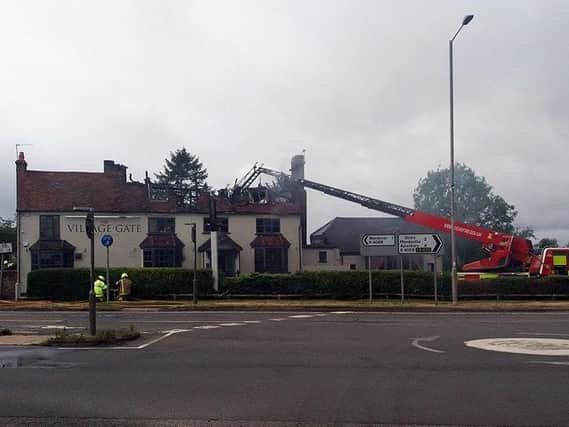Fire that destroyed historic Wendover pub just one of hundreds across the UK since Notre Dame blaze


Included in these figures, is the historic Village Gate pub in Wendover, which burned down last year.
The pub, formerly named the Marquis of Granby can be traced back to the 16th Century.
Advertisement
Hide AdAdvertisement
Hide AdFires have damaged or destroyed more than 400 of the UK’s historic buildings since the devastating Notre Dame blaze in Paris exactly a year ago, analysis by a heritage safety expert shows.
They include the Grade II listed Claremont Hotel in Eastbourne, which had to be demolished, Fife’s category C listed former Viewforth High School and Fearnville House, a Grade II listed mansion in Leeds.
On average, a heritage building is hit by fire once a day in the UK, according to records compiled by specialist fire risk assessor Keith Atkinson.
He has called for tighter laws forcing owners of all heritage assets to boost their protection measures.
Advertisement
Hide AdAdvertisement
Hide AdMr Atkinson is co-author of the National Database of Fires in Heritage Buildings, which lists blazes reported by the media.
While the database is not an exhaustive list, it is believed to be the most comprehensive resource of its kind.
He said: “If it is a modern building that burns down, although disastrous for the owners and occupiers, hopefully it is insured and is easily rebuilt - but you cannot rebuild heritage.”
Mr Atkinson, a heritage specialist who runs a consultancy business near Chester, said the best way for these precious assets to be protected, especially from arsonists, was for them to be occupied and properly maintained.
Advertisement
Hide AdAdvertisement
Hide AdAnd he called for more financial incentives for developers to renovate old buildings.
He said: “The Government could help with this with grants for bringing an historic building back into use for much-needed housing, and by making renovation and essential maintenance work VAT-free.”
In England, where there have been at least 360 heritage fires in the past year, buildings open to the public need to have a fire risk assessment but historic private homes do not. Mr Atkinson called for this to change.
A Government spokesperson said responsible building owners should take appropriate measures to keep empty buildings safe and secure, adding: “We know heritage buildings hold great value to communities which is why we are investing £95 million to protect, regenerate and adapt these buildings, as well as protecting them through our planning system.”
Advertisement
Hide AdAdvertisement
Hide Ad“Fire poses a real threat to many historic places,” a spokesperson for Historic England warned.
“Historic buildings pose unique challenges - many were built before modern building regulations – but these can be mitigated with appropriate and sensitive fire prevention interventions.”
While the database records just five blazes in historic buildings in Northern Ireland in the past year, the vice chairman of Ulster Architectural Heritage John Anderson said fire was a major threat to the country’s heritage.
He said: “Although the database entries for Northern Ireland are few and far between, this does not reflect the serious problem of loss of, and, or major damage to, some of Northern Ireland’s most significant heritage buildings to fire.”
Advertisement
Hide AdAdvertisement
Hide AdA spokesperson for the Northern Ireland Department for Communities said: “Support has been provided for work to heritage buildings by Government in many ways over the years and this is kept under review relative to available budgets. VAT policy is not devolved to Northern Ireland and is a matter for the UK Government.”
In Scotland, there have been more than 40 fires in heritage buildings in the past year, the database shows.
A spokesperson for Historic Environment Scotland (HES) said: “HES works closely with owners of listed and historic buildings to provide advice, and we have published detailed guidance on fire safety management for historic buildings which sets out the principles which should be applied.”